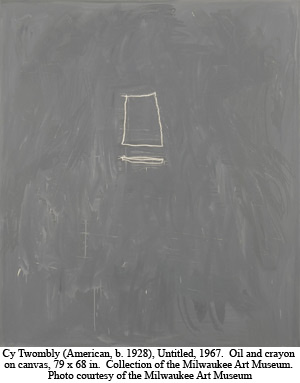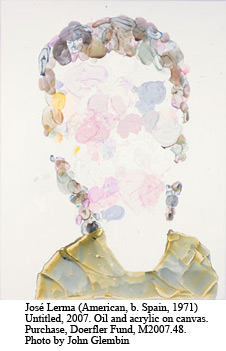Saturday & Sunday
 It’s Saturday, February 2 – Groundhog Day – and I’m at the Milwaukee Art Museum to cruise the newly configured contemporary galleries, where MAM’s Chief Curator Joe Ketner has shaped a fresh path to “seeing.” The elevator carries me upward from the heated garage (what a waste of energy!) to Windhover Hall, where preparations are underway for a late afternoon wedding. Visiting groups gather in clusters around the pretentious Dale Chihuly glass sculpture. The Calatrava addition speaks for itself and doesn’t need doo-dads, but go ahead, smile for the camera. Art Lives Here.
It’s Saturday, February 2 – Groundhog Day – and I’m at the Milwaukee Art Museum to cruise the newly configured contemporary galleries, where MAM’s Chief Curator Joe Ketner has shaped a fresh path to “seeing.” The elevator carries me upward from the heated garage (what a waste of energy!) to Windhover Hall, where preparations are underway for a late afternoon wedding. Visiting groups gather in clusters around the pretentious Dale Chihuly glass sculpture. The Calatrava addition speaks for itself and doesn’t need doo-dads, but go ahead, smile for the camera. Art Lives Here.
I’m looking for Cy Twombly’s “Untitled,” missing from its regular spot on the east wall of the Flagg Gallery with another “Untitled,” a 2007 oil and acrylic painting by Jose Lerma, in its place. My first thought is, “these whirls of pastel blobs belong on a cupcake.” I hope Lerma moved on to become a pastry chef. Prior to receiving a 2001 MFA in Painting from the University of Wisconsin-Madison, he studied law.
The security guards chat about their personal choices and offer some tidbits. One chap admires Lichtenstein’s “Imperfect Diptych, 1983,” a 2007 gift from Rockwell Automation, and another tells me that the large Philip Pearlstein paintings (from 1966 and 1969) have switched places in the Marcus Gallery. The girl in the chair currently sits on the left; her nude friend reclines on the right.
And the Twombly? Perhaps on loan to a distant place, maybe with Robert Gober’s “Untitled,” a bottomless suitcase set above a tableau under the floor. Or are the two consigned to a storage area in the bowels of MAM?
The Selig Gallery now has four works by Andy Warhol on loan from the collection of Mark and Debbie Attanasio, owners of the Milwaukee Brewers. They’re mediocre examples, like underdone leftovers – a body builder, several hamburgers, and a black and white “Campbell’s Soup (Tomato, 1985)” – although they do serve as links to the artist’s fascination with the world of advertising. Two far more accomplished Warhol Soup Can paintings from the Museum’s permanent collection score. If your favorite in this gallery is Jasper Johns 1984 “Untitled,” fear not; it still reigns supreme.
 I return to MAM on Super Bowl Sunday yearning for the Twombly. I enter section 16, which announces “The Transition of Modern Art,” a particular interest of Joe Ketner, who used to have one of the three Manierre Dawson (1887-1969) paintings in his office, along with a great Fernand Leger. In an earlier interview he told me that having them near helped him consider the transition problem, which is not the transition to contemporary art, or even post-modern art, but, as Ketner explained in an email, the emergence of European modernism in the United States. He adds that the capital of the art world at the time was not New York but Paris, and that it was the International Exhibition of Modern Art (the Armory Show), held in New York in 1913, that brought European modernism to the nation’s attention.
I return to MAM on Super Bowl Sunday yearning for the Twombly. I enter section 16, which announces “The Transition of Modern Art,” a particular interest of Joe Ketner, who used to have one of the three Manierre Dawson (1887-1969) paintings in his office, along with a great Fernand Leger. In an earlier interview he told me that having them near helped him consider the transition problem, which is not the transition to contemporary art, or even post-modern art, but, as Ketner explained in an email, the emergence of European modernism in the United States. He adds that the capital of the art world at the time was not New York but Paris, and that it was the International Exhibition of Modern Art (the Armory Show), held in New York in 1913, that brought European modernism to the nation’s attention.
Ketner advised that “there is no right or wrong way to walk through or approach the galleries.” He thinks (and I agree) that “it might be interesting to find examples of abstract paintings hung in different areas: [look at] our Manierre Dawson painting in the early modernist gallery and the Wassily Kandinsky painting in the Bradley galleries, and the Georgia O’Keeffe paintings.”
With Ketner’s counsel in mind, I make my way to the Marcia and Granvil Specks Gallery. The January 28, 2008 issue of The New Yorker has a spread profiling the career of John Currin and his recent “pornographic paintings.” The artist certainly doesn’t need a porn twist to pump his work, but the article is highly informative. In 2003, MAM mounted a show of Currin’s drawings from 1991-2002, and compared with what the artist has been up to lately, they seem like slices of foreplay. The Specks isn’t a shrinking violet, and several of its prints let it all hang out, including “Women’s Bath,” a 1922-25 drypoint by Paul Kleinschmidt, and “Reclining Nude (Seated Woman with a Cigarette)” a 1923 Otto Dix lithograph. Call them the bold and the beautiful, whatever, these two and others in the Specks define the meaning of line, the most basic of all art-making elements.
I locate the elusive Twombly in area 18 (Abstract Expressionism). Simple and uncontrived, the oil on canvas (marked with wax crayon) resembles a dusty blackboard. A viewer remarks, “My kid could do that.” I’ve heard that before and will hear it again.
First time visitors will be unaware of the various changes in the contemporary galleries, and those who’ve haunted the halls for decades will either like or dislike the transformation. Even though I recognize familiar images along my route, Ketner’s re-think is subtle and politely seamless.
My second favorite piece, Martin Puryear’s “Maroon,” is at the Modern Art Museum of Fort Worth, Texas until May 18, when it moves on to Washington, D.C.’s National Gallery of Art, before ending its tour on January 29, 2009 at the San Francisco Museum of Modern Art. I miss its dark bulbous shape. The aforementioned Gober is undergoing conservation.
Changes can be good, bad or irrelevant. In this political year when everyone is shouting for change, the changes made where art lives get my vote. VS
















